Abstract
Using common corn stalks as raw materials, a functional dense-structured carbon microsphere with good elastic deformation and certain rigid support was modified from biomass through a step-by-step hydrothermal method. The composition, thermal stability, fluid-loss reduction performance, and reservoir protection performance of the modified carbon microspheres were studied. Research indicates that after hydrothermal treatment, under the multi-level structural action of a small amount of proteins in corn stalks, the naturally occurring cellulose, polysaccharide organic compounds, and part of the ash in the stalks are adsorbed and encapsulated within the long-chain network structure formed by proteins and cellulose. By attaching silicate nanoparticles with certain rigidity from the ash to the relatively stable chair-type structure in cellulose, functional dense-structured carbon microspheres were ultimately prepared. These carbon microspheres could still effectively reduce fluid loss at 200 °C. The permeability recovery value of the cores treated with modified biomass carbon microspheres during flowback reached as high as 88%, which was much higher than that of the biomass itself. With the dense network-like chain structure supplemented by small-molecule aldehydes and silicate ash, the subsequent invasion of drilling fluid was successfully prevented, and a good sealing effect was maintained even under high-temperature and high-pressure conditions. Moreover, since this functional dense-structured carbon microsphere achieved sealing through a physical mechanism, it did not cause damage to the formation, showing a promising application prospect.
1. Introduction
With the development of the petroleum industry, the formation conditions for drilling are becoming increasingly complex, and drilling technology, especially the application of drilling fluids, is facing more challenges [1]. For instance, excessive variations in formation temperature and salinity can lead to unstable properties of drilling fluids. Excessive fluid loss from drilling fluids can result in reservoir damage and even well-collapse accidents [2]. To address this challenging issue, researchers have opted to add fluid-loss additives to drilling fluids to reduce the fluid loss of drilling fluids, thereby playing a role in protecting the wellbore and the reservoir [3]. Therefore, it is of crucial importance to develop environmentally friendly additives with significant fluid-loss reduction effects.
A significant amount of work on the research and development of drilling fluids has been carried out by relevant scholars. In the early stages of drilling fluid research, traditional minerals and inorganic compounds were used as drilling fluid additives [4]. However, as geological conditions deteriorated, these materials could no longer solve drilling problems. Consequently, plugging-type fluid-loss additives came into the focus of researchers. High-temperature plugging fluid-loss additives with good field application performance can be mainly classified into two categories [5,6]. One category comprises water-soluble products such as SMP-1, SP, SCSP, and SLSP [7]. The other category consists of products that are partially both hydrophilic and lipophilic, like sulfonated asphalt and modified asphalt [8]. Both types of fluid-loss additives have certain functions in preventing wellbore collapse and protecting oil reservoirs during practical applications. Nevertheless, they also have some shortcomings. For example, their excessive solubility in water leads to complete dissolution at high temperatures, which reduces the plugging effect [9]. Kong Yong et al. [10] summarized and analyzed low-fluorescence anti-collapse asphalt and low-fluorescence special-effect plugging, anti-collapse, and fluid-loss reducing agents. Products such as LF-TEX-1 and FSL-1 can effectively reduce fluid loss by increasing the sulfonation degree of petroleum asphalt and also have the ability to prevent misjudgment or false judgment of oil reservoirs. Tang Meng et al. [11] developed a plugging-type PAAM as a fluid-loss additive, which showed good fluid-loss reduction performance. Wei Jun et al. [12] developed a modified corn starch fluid-loss additive with a fluid-loss reduction rate of about 45%. In addition, foreign scholars have also developed modified cellulose-based fluid-loss additives [13], which exhibit certain fluid-loss reduction effects.
However, water-soluble fluid-loss additives such as polymers have unstable chemical properties under complex conditions, such as high formation temperatures and high salinities, which affect their fluid-loss reduction performance. In contrast, particulate plugging agents, suspended in drilling fluids, can maintain stable chemical properties in the harsh environment at the bottom of the well. They rely on physical characteristics to play a role in reducing fluid loss and are more suitable for use under complex conditions [14]. Burkhalter et al. [15,16] developed a nanoscale fluid-loss additive, MAX-SHIELDTM, which can adsorb on the surfaces of pores or fractures and form a sealing film, thereby reducing fluid loss and improving wellbore stability. Li et al. [17] developed a composite nano-fluid-loss additive and conducted preliminary tests, showing low fluid loss under high-temperature and high-pressure conditions. Tang Wenquan et al. [18] developed a new type of micro-nano plugging agent. The plugging experimental results indicated that the micro-nano structure greatly assisted the plugging effect.
In recent years, with the gradual enhancement of environmental protection awareness, the use of drilling fluids has been subject to increasingly stringent requirements imposed by environmental policies [19]. The development of new environmentally friendly drilling fluid additives has thus become one of the important topics of concern for technical personnel. Huang [20] applied biomass to drilling fluids and developed a new environmentally friendly plugging agent with good fluid-loss reduction performance. However, biomass has poor thermal stability, so it is necessary to conduct modification research on biomass to improve its stability. Huang Fei, He Leijuan, and others [21] prepared polymer fluid-loss additives using cellulose derivatives from biological straws.
In view of the increasingly complex drilling formation conditions, drilling fluid additives are facing challenges such as unstable performance under high temperatures and insufficient fluid-loss reduction and plugging effects, and difficulty in balancing environmental protection and economic considerations. Traditional mineral and inorganic additives can no longer meet the needs of complex formations. Water-soluble polymer additives are prone to performance failure under high temperatures, and some hydrophilic–lipophilic additives have reduced plugging effects under high temperatures and high pressures. Although biomass-based additives have the advantage of environmental protection, they have problems such as poor thermal stability and limited reservoir protection effects. Nano additives, while having certain plugging advantages, are often costly due to their reliance on chemical raw materials.
Inspired by relevant research, this study intends to modify biomass corn stalks to prepare carbon microspheres and investigate their stability, fluid-loss reduction performance, environmental protection performance, and application potential. By optimizing the preparation method and analyzing the performance, it is expected to provide a new idea for the development of high-performance and environmentally friendly drilling fluid additives. The flowchart is shown in Figure 1.
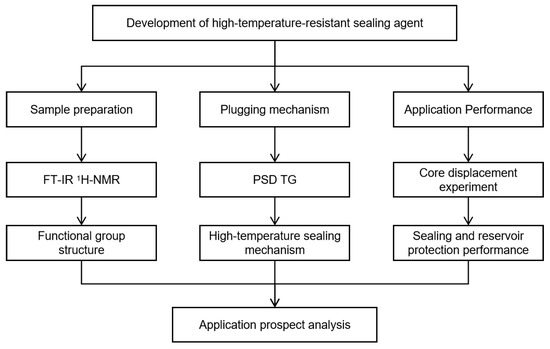
Figure 1.
Research flowchart.
2. Materials and Experiments
2.1. Experimental Reagents and Instruments
Corn stover, triphenylphenol, toluene, ethanol (all analytical grade, purchased from Aladdin Reagent Company, Shanghai, China), deionized water, NaCl, bentonite, and sandstone core (purchased from China National Pharmaceutical Group, Beijing, China) were used.
An EW-177 high-speed universal crusher, a KMS-521D magnetic stirrer (50 W/L), a DHG-9057A blast drying oven, a KQ-600 ultrasonic cleaning instrument, a Centrifuge 5804 high-speed centrifuge, a CW-2000 ultrasonic microwave synergistic extraction instrument, a NEXUS-870 Fourier transform infrared spectrometer, a TG209-F3 thermogravimetric analyzer, an SD-4 API filtration instrument, and an XGRL-4A-type, CGYQT-180-type core displacement experimental device were used. The cost estimation is shown in Table 1.

Table 1.
Cost estimation results for indoor preparation of 1 g sample.
2.2. Preparation and Performance Evaluation Methods of Samples
- (1)
- Material selection and preparation methods. At present, there are many kinds of biomass on sale in the market, including corn starch, wheat starch, etc. The preparation methods include the lotion polymer method, high-temperature pyrolysis method, mechanical grinding method, etc. Considering the cost of raw materials, environmental protection, stability, etc., corn straw was selected as the biomass raw material, and carbon microspheres were prepared by the hydrothermal method.
- (2)
- Infrared spectroscopy analysis. Using an infrared spectrometer (Thermo Fisher Scientific, Waltham, MA, USA), the infrared spectra of biomass and modified carbon microspheres were tested using the KBr pellet method.
- (3)
- Thermogravimetric analysis. Using a TGA thermogravimetric analyzer (TA Instruments, Leatherhead, UK), the thermal stability of biomass and modified carbon microspheres was tested. The heating rate was 10 °C/min, the atmosphere was nitrogen, and the heating range was 20–800 °C.
- (4)
- Filter loss performance testing. An API filtration tester was used to test the filtration loss of the bentonite slurry and the biomass and modified carbon microspheres added, and to test the filtration loss after hot-rolling at 180 °C and 200 °C, respectively, in order to evaluate their high-temperature filtration performance.
- (5)
- Core displacement experiment. Using a core displacement experimental device (Hai’an Petroleum Research Instrument Co., Ltd., Nantong, China), the recovery of core backflow permeability after treatment with different working fluids was tested, and the protective performance of biomass and modified carbon microsphere reservoirs was evaluated. The displacement fluid used was a 0.5% (wt) NaCl solution, and the cores used were all self-made sandstone cores.
- (6)
- Salt resistance test. Using the bentonite base slurry (Jitian Chemical Co., Ltd., Shenzhen, China) as the control group, the rheological and filtration properties of the drilling fluid before and after adding plugging agents were compared.
- (7)
- Core self-suction experiment. Core self-priming experiments were simulated using drilling fluid base slurry and materials with added plugging agents, and the effectiveness of the plugging agent was determined based on the amount of self-priming.
3. Synthesis Principle of Modified Biomass Carbon Microspheres
Currently, the main methods for producing carbon microspheres include chemical vapor deposition (CVD), arc discharge, the hydrothermal method, mechanical grinding, high-temperature pyrolysis, emulsion polymerization, etc. The raw materials for making carbon microspheres can be classified into traditional chemical raw materials and biomass raw materials. With the increasing shortage of traditional fossil resources such as coal and oil, biomass raw materials are gradually being developed as carbon sources. Due to its environmental advantages, the hydrothermal method has become an important approach for preparing biomass-derived carbon microspheres. In this paper, a two-step hydrothermal method (low-temperature hydrothermal and high-temperature hydrothermal) is employed to prepare functional dense-structured carbon microspheres.
3.1. Preparation of Functional Dense-Structured Carbon Microspheres by Hydrothermal Method
Referring to the method of preparing oil tea seed shell carbon microspheres by the stepwise hydrothermal method, biomass carbon microspheres were prepared using common corn stover as the raw material. The main preparation process consisted of three steps: pretreatment, low-temperature hydrothermal treatment, and hydrothermal carbonization.
3.1.1. Biomass Pretreatment
After the straw was naturally dried, it was crushed with a grinder and sieved through a 200 mesh sieve, and the powder was set aside. Separately, 30 g of straw powder was weighed and 450 mL of toluene–ethanol mixed solvent was added, and the sample was sonicated for 1 h, then soaked for 24 h. The solid obtained by vacuum filtration was ground after vacuum drying to obtain the pretreated biomass powder. The ultrasonic vibration frequency in the experiment was 20 kHz. When preparing the biomass powder, the volume ratio of toluene to ethanol in the mixed reagent was 3:1.
3.1.2. Hydrothermal Treatment
Two grams of pretreated biomass powder was added to 60 mL of deionized water. It was dispersed by ultrasound for 1 h and stirred for 6 h. Then, it was heated in a PSA-type high-temperature reactor (Zhengxin Instrument Co., Ltd., Najing, China) for 4 h (180 °C, 0.5 MPa) and filtered to obtain a solid, and the solid was vacuum-dried to obtain a residue.
3.1.3. Hydrothermal Carbonization Treatment
The residue obtained by low-temperature hydrothermal treatment was added to meta phenyltriphenylphenol, sonicated and dispersed in 54 mL of deionized water, stirred for 6 h, and then subjected to hydrothermal carbonization in a reaction vessel for 8 h (230 °C). After natural cooling, it was filtered to obtain a solid. Ethanol and water were added to the solid, and it was washed alternately with ultrasounds and microwaves five times before being filtered again. The obtained solid was dried in a vacuum-drying oven to obtain modified biomass carbon microspheres.
3.2. Preparation Mechanism
The preparation mechanism of the carbon microspheres is illustrated in Figure 2a. The main components of corn stalks are cellulose, along with some proteins, ash (with silicates as the major components), and polysaccharides (mainly polymeric sugar-based organic substances such as dextran, xylan, and arabinan). After the pretreatment of corn stalks, most of the insoluble ash, solid particles, and lumpy impurities are removed. Meanwhile, the dust that is insoluble in organic solutions is also eliminated, resulting in a relatively pure organic-matter substrate.
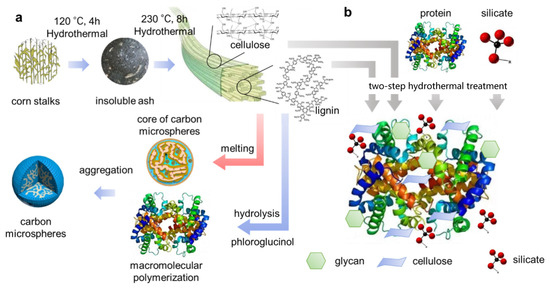
Figure 2.
Preparation process and synthesis mechanism of modified biomass carbon microspheres. (a) Schematic diagram of the synthesis mechanism of biomass-based carbon microspheres. (b) Schematic diagram of the carbon microsphere formation synthesis process.
A schematic diagram of the microscopic synthesis mechanism is shown in Figure 2b. During the low-temperature hydrothermal stage, most of the cellulose and lignin remain unhydrolyzed. A small amount of impurities that are difficult to form into spheres are hydrolyzed and then removed. Some silicates are adsorbed onto the multi-level structures formed by a small amount of proteins through ionization and high-pressure adsorption during the initial low-temperature hydrothermal stage. Although the protein content in corn stalks is relatively low, with a mass percentage of approximately 5.53–6.33%, due to the long-chain polymer characteristics of the protein structure and its multi-level structural properties, the quaternary structure of protein molecules forms a natural reticular carbon skeleton. The linear long chains in the primary structure are conducive to providing a highly ordered arrangement of carbon atoms, facilitating the polymerization of carboxyl and hydroxyl functional groups. This is because the highly ordered long-chain carbon skeleton avoids the situation where carboxyl and hydroxyl groups cannot successfully bond with the long-chain carbon skeleton due to spatial constraints. The secondary structure, which is mostly planar and often in a helical or folded arrangement, and the tertiary structure, which often presents as a three-dimensional structure providing effective branches through the extension of molecular chain side chains, ultimately enable the full integration of cellulose, polysaccharides (such as dextran, xylan, arabinan, and other polymeric sugar-based organic substances), and silicates under the action of the protein’s multi-level structure [22,23].
In the high-temperature hydrothermal carbonization stage, under the high-temperature and high-pressure conditions of the hydrothermal reactor, the incompressible molecules at the microscopic level, such as silicates, are firmly anchored within the main and side chains of the protein molecules by the protein’s multi-level structure. The silanol groups (Si–OH) on the silicate surface can form hydrogen bonds with hydroxyl (-OH) groups in cellulose or amide (-CONH) groups in proteins, creating a stable interfacial interaction. Most of the cellulose is hydrolyzed into aldehyde compounds, while most of the lignin and some of the polysaccharides (such as dextran, xylan, arabinan, and other polymeric sugar-based organic substances) are hydrolyzed into phenolic compounds. The artificially added phloroglucinol serves as another part of the organic carbon source, providing benzene ring structures to increase the spatial density at the molecular level. Furthermore, triphenylphenol can partially transform into highly stable aromatic carbon structures (e.g., graphitic or amorphous carbon) via polycondensation of its aromatic rings. A small portion of the phenolic compounds melts to form the core of the carbon microspheres [24,25].
In addition, under the action of triphenylphenol, the compounds produced by hydrolysis undergo condensation reactions to form macromolecular polymers, which aggregate on the surface of carbon microspheres and ultimately form carbon microspheres.
4. Results and Discussions
4.1. Analysis of Infrared Spectroscopy
The infrared spectra of biomass and biomass-derived carbon microspheres are shown in Figure 3. For the biomass material, the absorption peak at a wavenumber of 3418 cm−1 corresponds to the stretching vibration peak of the O-H single bond. The peak at 2988 cm−1 is attributed to the stretching vibration peak of the C-H single bond. The absorption peak at 2086 cm−1 represents the stretching vibration peak of =C-H, indicating the presence of benzene ring structures and unsaturated double bonds in proteins.
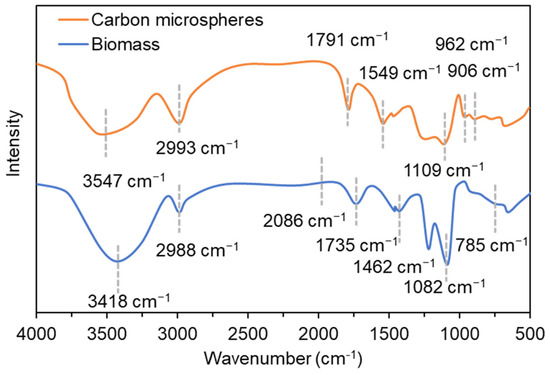
Figure 3.
Infrared spectrum curves of biomass and modified carbon microspheres.
The peak at 1735 cm−1 corresponds to the bending vibration peak of the O-H single bond. The peak at 1462 cm−1 is the stretching vibration peak of the C-O single bond, and the peak at 1082 cm−1 is the stretching vibration peak of the C-C single bond, proving the existence of C-C single bonds in the long-chain carbon skeleton. The absorption peak at 785 cm−1 is the C-H vibration peak of ortho-disubstituted benzene, which confirms the presence of benzene rings generated from the polysaccharides in the corn stalks and the benzene rings in phloroglucinol.
For the biomass-derived carbon microspheres material, the absorption peak at a wavenumber of 3547 cm−1 corresponds to the stretching vibration peak of the O-H single bond. The peak at 2993 cm−1 is attributed to the stretching vibration peak of the C-H single bond. The absorption peak at 2086 cm−1 represents the stretching vibration peak of =C-H, indicating the presence of benzene ring structures and unsaturated double bonds in proteins. The peak at 1791 cm−1 corresponds to the bending vibration peak of the O-H single bond. The peak at 1549 cm−1 is the stretching vibration peak of the C-O single bond, and the peak at 1109 cm−1 is the stretching vibration peak of the C-C single bond, proving the existence of C-C single bonds in the long-chain carbon skeleton.
The absorption peak at 906 cm−1 is due to the bending vibration of the double-bond terminal =C-H in the proteins present in the corn stalks. The absorption peak at 962 cm−1 is attributed to the =C-H bending vibration of the double-bond terminal R1CH=CHR2 (trans) in the long-chain protein molecules of the corn stalks. This peak indicates that the long-chain protein molecules have successfully grafted side-chain molecules through functional groups. In the infrared spectrum of biomass-derived carbon microspheres, characteristic peaks at 3547 cm−1, 2993 cm−1, 1791 cm−1, 1549 cm−1, and 1109 cm−1 are all present. Through comparison, it is found that the hydrothermal carbonization reaction has not altered the main components of the biomass.
4.2. Thermogravimetric Analysis
The thermogravimetric (TG) curves of biomass and functional dense-structured carbon microspheres are shown in Figure 4. It shows that when the temperature gradually increases from room temperature (25 °C) to 100 °C at a heating rate of 10 °C/min, the mass loss of both biomass and functional dense-structured carbon microspheres is linear, and the difference is not significant. Analysis indicates that the mass decay in this stage is mainly due to the evaporation of adsorbed water within the biomass and functional dense-structured carbon microspheres, with the mass loss accounting for approximately 12% of the total mass.
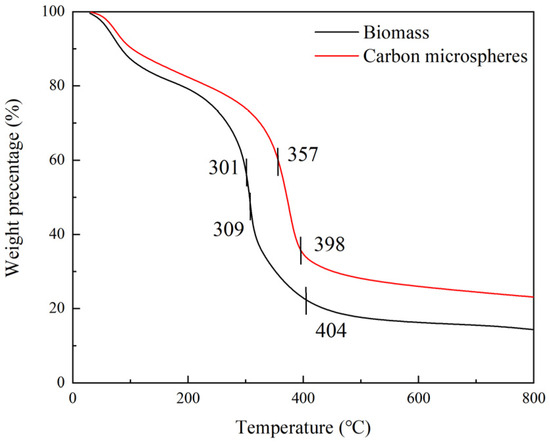
Figure 4.
Thermogravimetric analysis results of modified carbon microspheres.
In the temperature range of 100–300 °C, with a heating rate of 20 °C/min, the weight loss in this stage is very small, accounting for about 13% of the total mass. Through comparison, it is found that the mass of biomass powder decays preferentially and to a more significant extent, while the mass decay of functional dense-structured carbon microspheres is relatively delayed and the decay amplitude is smaller. Analysis of this phenomenon suggests that the thermal stability of functional dense-structured carbon microspheres is significantly improved within this temperature range. The bonding between various side chains and functional groups is more robust, making them less prone to decomposition.
In the stage of 300–400 °C, with a heating rate of 20 °C/min, the weight loss increases sharply. This stage is mainly dominated by the decomposition of organic matter. Comparison shows that the mass loss is approximately 38%, while the mass loss of biomass is about 45%. Even at a high temperature of 300 °C, the functional dense-structured carbon microspheres still exhibit a significant delay in mass decay, further indicating that the modified carbon microspheres have a relatively dense structure and good thermal stability, thus significantly enhancing their heat resistance at high temperatures.
In the temperature range of 400–800 °C, with a heating rate of 30 °C/min, there is almost no increase in weight loss. The final mass retention of biomass is about 13%, while that of functional dense-structured carbon microspheres is approximately 23%. This indicates that the cross-linking of polymers and long-chain macromolecules formed through the hydrothermal process can effectively stabilize the side chains and ash components on the main chain, avoiding the decomposition loss of silicates that are subjected to stress.
In summary, within each temperature range, the weight retention rate of the residual carbon microspheres is greater than that of the biomass. This demonstrates that after the biomass undergoes hydrothermal carbonization to form carbon microspheres, its thermal stability increases.
4.3. Analysis of Particle Size Distribution
Rice straw biomass and modified functional dense-structured carbon microspheres were separately dissolved in anhydrous ethanol to prepare solutions with a mass concentration of 0.2%. These solutions were then subjected to ultrasonic dispersion for 30 min at 35 °C. A particle size analysis experiment was carried out using an OMCC LS-609-type laser particle size analyzer (Zhuhai Ouaike Instrument Co., Ltd., Zhuhai, China). The measured particle size distribution results are shown in Figure 5. The particle sizes of straw biomass are mainly concentrated in the range of 200–450 µm, while the particle sizes of modified functional dense-structured carbon microspheres are mainly concentrated in the range of 150–345 µm (PDI = 0.531). A wide range of particle size distributions can enhance its universality in sealing pore throats. It is clearly evident that the particle size of the modified carbon microspheres is smaller than that of the corn straw particles. This is because under the effect of high-temperature hydrothermal conditions, decomposition and polymerization of high-molecular-weight substances occur, and the intermolecular cross-linking becomes more compact. Additionally, as shown in Figure 6, the primary particle size of modified functional dense-structured carbon microspheres was determined to be approximately 200 µm through high-resolution imaging analysis, which is consistent with the hydrodynamic diameter measured by dynamic light scattering (DLS) after dispersion.
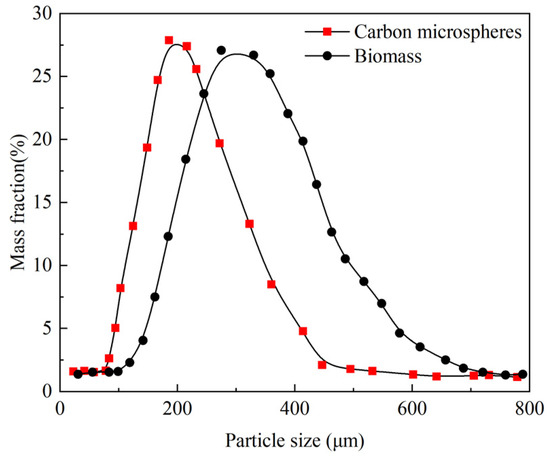
Figure 5.
Particle size distribution curve of stover biomass and modified functional dense-structured carbon microspheres.
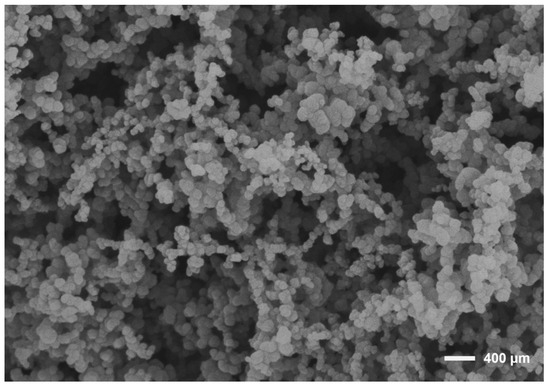
Figure 6.
Scanning electron microscopy (SEM) image of modified functional dense-structured carbon microspheres. Scale bar is 200 µm.
4.4. Analysis of 1H-NMR
To investigate the specific molecular structure of functional dense-structured carbon microspheres, an Anasazi EFT-60 nuclear magnetic resonance (NMR) spectrometer from the United States was used to conduct H-proton analysis on the material. Deuterated methanol was employed as the dispersant for the H-NMR spectrum analysis. The H-NMR spectrum results are shown in Figure 7.
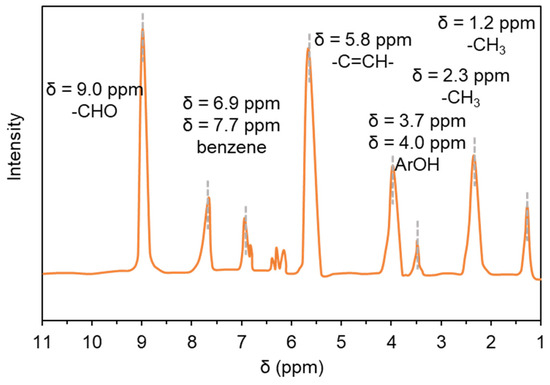
Figure 7.
1H-NMR spectrum of functional dense-structure carbon microspheres.
The peak at a chemical shift of δ = 1.2 ppm is due to the -CH3 group at the end of long-chain molecules. The peak at δ = 2.3 ppm is attributed to the -CH2- group in the carbon skeleton. The peaks at chemical shifts of δ = 3.7 ppm and δ = 4 ppm are caused by the ArOH functional groups from polysaccharides and phloroglucinol. The peak at δ = 5.8 ppm arises from the -C=CH- group formed after the decomposition and condensation polymerization of cellulose molecules. The peaks at δ = 6.9 ppm and δ = 7.7 ppm are due to the hydrogen atoms in the benzene rings. The peak at δ = 9 ppm is caused by the -CHO functional group generated during the decomposition of phenolic substances.
4.5. Analysis of Filter Loss Reduction Performance
In a 4% bentonite-based mud, 1% biomass and 1% carbon microspheres were added, respectively. The API fluid loss over time was measured before hot-rolling and after hot-rolling at 180 °C and 200 °C for 10 h.
Figure 8 shows the mechanism of action of the material. The large spherical particles represent the main bridging agents in the drilling fluid, the smaller irregularly shaped particles are the secondary filling materials, and the interconnected network lines symbolize the gel-like matrix formed by the polymer in the drilling fluid. The large spherical particles first form a primary bridge across the pores in the formation. Their relatively large size and spherical shape enable them to span the larger pore throats, reducing the effective size of the flow channels. The smaller irregularly shaped particles then fill in the gaps between the large spherical particles, further reducing the pore size and enhancing the sealing effect. This is similar to the principle of multi-sized particle-based plugging in many previous studies [3]. The gel-like matrix formed by the polymer in the drilling fluid not only holds these particles together but also coats the pore walls. This coating reduces the surface roughness of the pores and provides an additional barrier to fluid flow, thereby reducing the filtration loss. The polymer matrix can also adjust its viscosity and gel strength under different shear and temperature conditions, maintaining the integrity of the filter cake formed on the formation surface.
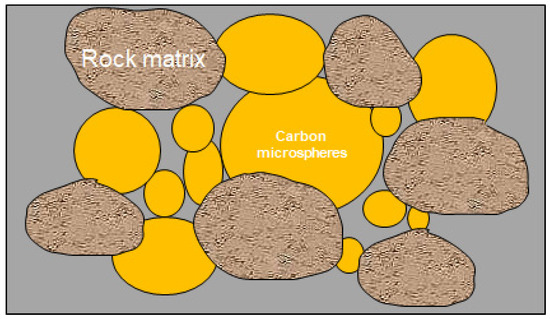
Figure 8.
The action mechanism of carbon microspheres.
Before hot-rolling, the fluid losses of the bentonite-based mud, the mud with added biomass, and the mud with added functional dense-structured carbon microspheres were 30.2 mL, 24.7 mL, and 14.3 mL, respectively. After hot-rolling at 180 °C, the fluid losses were 36.8 mL, 27.3 mL, and 16.7 mL for the bentonite-based mud, the mud with added biomass, and the mud with added functional dense-structured carbon microspheres, respectively. After hot-rolling at 200 °C, the fluid losses were 43.4 mL, 31.9 mL, and 18.1 mL for the bentonite-based mud, the mud with added biomass, and the mud with added carbon microspheres, respectively.
The addition of biomass significantly reduces the fluid loss, and the carbon microspheres derived from biomass show a better fluid-loss reduction effect compared to adding biomass alone. Compared with the situation before hot-rolling, the API fluid loss increases after hot-rolling. However, the increase in API fluid loss is relatively smaller after adding biomass and carbon microspheres, indicating that the biomass-derived carbon microspheres have good temperature resistance and can still effectively reduce the fluid loss at 200 °C.
Analysis shows that both biomass powder and functional dense-structured carbon microspheres can reduce the fluid loss of the base mud, but the functional dense-structured carbon microspheres have a more pronounced effect. The main reason is that the modified functional dense-structured carbon microspheres bond a large number of side chains through the protein C-skeleton in corn stalks, thereby increasing the cross-linking interactions between long-chain polymers. This makes the internal structure of the carbon microspheres denser, enabling them to more effectively block the penetration of the base mud and thus reduce the fluid loss.
By comparing the hot-rolling data at 180 °C and 200 °C, it is found that the functional dense-structured carbon microspheres still have an excellent fluid-loss reduction effect after hot-rolling. The reason is that the modified carbon microspheres are cross-linked with each other through the multi-level structure of proteins, successfully “locking” the ash (silicates) in corn stalks within the molecular chains. This inhibits the condensation polymerization reaction of the molecular chains at high temperatures, effectively preserving the original molecular cross-linking structure of the functional dense-structured carbon microspheres.
As shown in Figure 9, it can be observed that the API fluid loss gradually increases with time. The addition of both biomass and functional dense-structured carbon microspheres can reduce the fluid loss of the base mud.
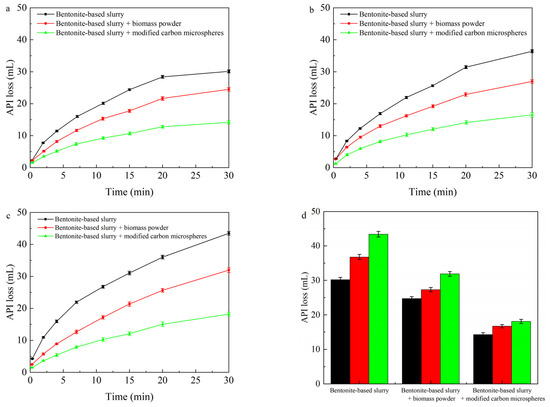
Figure 9.
Filtration loss before and after thermal rolling at different temperatures. (a) Before thermal rolling. (b) After thermal rolling at 180 °C. (c) After thermal rolling at 200 °C. (d) API filtration loss change diagram.
4.6. Analysis of Reservoir Protection Performance
Core displacement experiments were conducted to test the changes in core permeability before and after the displacement of working fluids, which included the bentonite-based mud, the mud with added biomass, and the mud with added biomass-derived carbon microspheres. This was done to evaluate the reservoir protection performance after adding biomass and carbon microspheres. The test results are shown in Table 2.

Table 2.
Testing of protective performance of biomass and carbon microsphere reservoirs.
As can be seen from Table 1, the core permeability recovery value after displacement with the bentonite-based mud is only 78%. After adding biomass, the permeability recovery value reaches 84%. And after adding biomass-derived carbon microspheres, the permeability recovery value is as high as 88%. Previous works show that the permeability recovery value of existing commercial polymer temporary plugging agents is usually around 30% [26,27,28,29]. This indicates that both biomass and carbon microspheres, through their temporary plugging mechanisms, prevent the subsequent drilling fluid from continuously invading the formation, thereby achieving the effect of protecting the formation.
Biomass and microcarbon balls were immersed in 20 g of sodium carbonate solution with a pH of 9, placed in an oven at 180 °C for a certain period of time, removed, rinsed three times with distilled water, and then dried in a vacuum-drying oven at 105 °C until a constant weight was achieved. Their mass was measured, and the degradation rate was calculated. The experimental results are shown in Figure 8.
As shown in Figure 10, the degradation extent of the temporary plugging agent increases with increasing degradation time. This is because, under high-temperature conditions, the vigorous movement of water molecules accelerates attacks on peptide bonds, thereby accelerating the breakage of peptide bonds between molecules. The higher the temperature, the faster the rate of peptide bond breakage, and the faster the degradation rate.
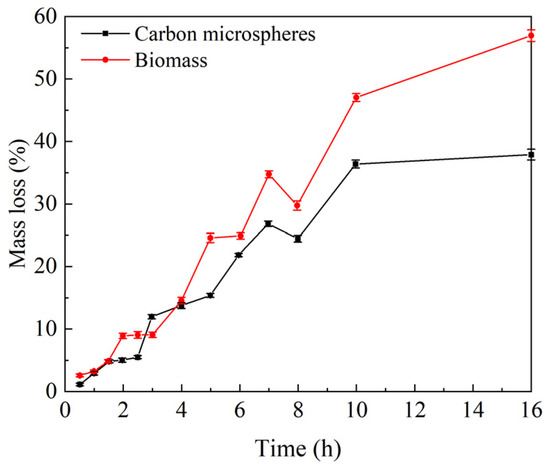
Figure 10.
Thermal degradation mass loss rate under high temperature conditions of biomass and carbon microspheres.
4.7. Analysis of Environmental Performance
To assess the environmental impact of this material, a biotoxicity testing method was employed to evaluate the biotoxicity of functional dense-structured carbon microspheres. The test method characterized the material’s environmental performance using the EC50 value. The test results are presented in Figure 11. The specific classification of biotoxicity evaluation results is shown in Table 3 below.
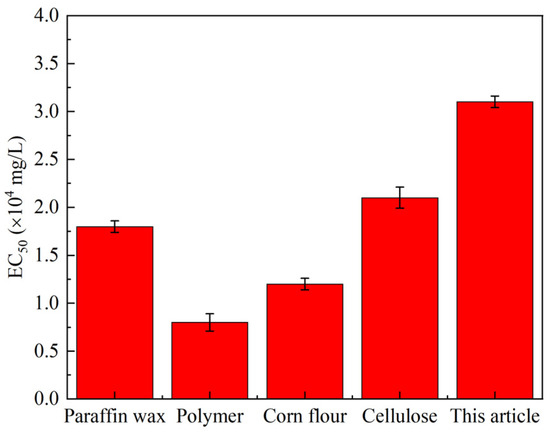
Figure 11.
Comparison of biological toxicity results of modified carbon spheres and different substances.

Table 3.
Biological toxicity classification table.
Figure 11 shows that when comparing the functional dense-structured carbon microspheres with previous polymers, white oil, cellulose, and corn flour, the EC50 value of this material is 31,000 mg/L, which is greater than 25,000 mg/L. Therefore, the functional dense-structured carbon microspheres exhibit good environmental performance.
4.8. Analysis of Salt Resistance Performance
Table 4 shows that after the addition of divalent salt ions, the rheological properties of drilling fluid significantly decrease. This is because salt ions cause clay to flocculate, resulting in a decrease in viscosity, but their impact on the sealing effect of carbon microspheres is relatively small.

Table 4.
Results of rheological and filtration properties of drilling fluid (hot-rolling at 180 °C/16 h).
The carbon microspheres form a dense network-like structure through the multi-level structural action of proteins, which adsorb and encapsulate cellulose, polysaccharides, and silicate ash. Their plugging effect relies on a physical sealing mechanism rather than chemical reactions. This physical mechanism theoretically reduces the likelihood of specific chemical interactions with Ca2+ or Mg2+, unlike some chemical additives that may undergo flocculation or decomposition in high-ion environments.
4.9. Analysis of Core Self-Priming Performance
Figure 12 shows that after adding carbon microspheres, the mass increment of the core free adsorption was smaller than that of the control experimental group, indicating that they have a good sealing effect and can form mud cakes on the rock surface. The mechanism of action is similar to the filtration reduction mechanism.
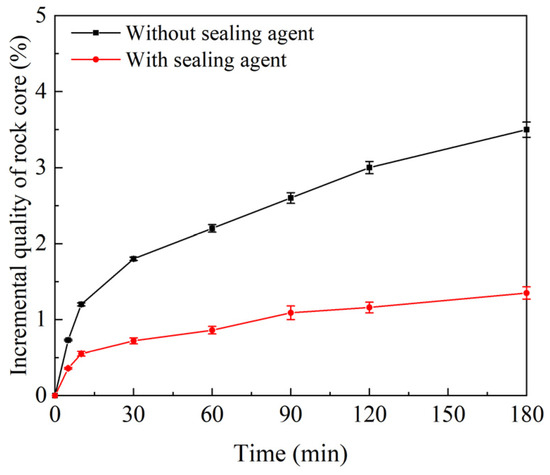
Figure 12.
Results of core self-priming test.
5. Conclusions
The study successfully demonstrates the preparation of functional dense-structured carbon microspheres from corn stover using a two-step hydrothermal method, highlighting their superior thermal stability, fluid-loss reduction, and reservoir protection properties compared to raw biomass.
Infrared spectroscopy and thermogravimetric analysis confirm that hydrothermal carbonization preserves the main components of biomass while significantly enhancing thermal stability, as evidenced by higher mass retention rates across all temperature ranges. The modified carbon microspheres exhibit smaller particle sizes and a denser structure, which contribute to their improved performance in reducing fluid loss and protecting reservoir permeability. Experimental results show that carbon microspheres reduce API fluid loss more effectively than biomass alone, maintaining their performance even after hot-rolling at 200 °C. Core displacement experiments further reveal that carbon microspheres enhance core permeability recovery up to 91%, outperforming both bentonite-based mud and biomass-added mud. Additionally, the carbon microspheres demonstrate good environmental compatibility, with an EC50 value indicating non-toxicity. These findings underscore the potential of biomass-derived carbon microspheres as high-performance, eco-friendly additives for drilling fluids and reservoir protection applications.
At present, research mainly focuses on indoor experiments, and the on-site large-scale application and systematic biological environmental performance testing of products are not sufficient. In future research, on-site collaboration with oilfields will be carried out to verify the long-term stability and field adaptability of the carbon microspheres under actual drilling conditions, promoting the transformation of experimental results to industrial applications.
Funding
This research received no external funding.
Data Availability Statement
The original contributions presented in this study are included in the article. Further inquiries can be directed to the corresponding author.
Conflicts of Interest
Miao Dong was employed by the Sinopec North China Company. The remaining authors declare that the research was conducted in the absence of any commercial or financial relationships that could be construed as a potential conflict of interest.
Abbreviations
| FTIR | Fourier Transform Infrared Spectroscopy |
| TGA | Thermogravimetric Analysis |
| 1H-NMR | Proton Nuclear Magnetic Resonance |
| API | American Petroleum Institute |
| EC50 | Half Maximal Effective Concentration |
| mD | Millidarcy |
| CVD | Chemical Vapor Deposition |
References
- Liu, Y.; Zhou, L.; Wan, X.; Tang, Y.; Liu, Q.; Li, W.; Liao, J. Synthesis and Characterization of a Temperature-Sensitive Microcapsule Gelling Agent for High-Temperature Acid Release. ACS Omega 2024, 9, 20849–20858. [Google Scholar] [CrossRef] [PubMed]
- Shah, S.N.; Shanker, N.H.; Ogugbue, C.C. Future challenges of drilling fluids and their rheological measurements. In Proceedings of the AADE Fluids Conference and Exhibition, Houston, TX, USA, 6–7 April 2010; pp. 5–7. [Google Scholar]
- Karakosta, K.; Mitropoulos, A.C.; Kyzas, G.Z. A review in nanopolymers for drilling fluids applications. J. Mol. Struct. 2021, 1227, 129702. [Google Scholar] [CrossRef]
- Abdo, J.; Haneef, M.D. Nano-enhanced drilling fluids: Pioneering approach to overcome uncompromising drilling problems. J. Energy Resour. Technol. 2012, 134, 014501. [Google Scholar] [CrossRef]
- Watson, R.; Viste, P.; Lauritzen, J. The influence of fluid loss additives in high-temperature reservoirs. In Proceedings of the SPE International Conference and Exhibition on Formation Damage Control, Lafayette, LA, USA, 15–17 February 2012; p. SPE-151662-MS. [Google Scholar]
- Wang, Q.; Cai, J.; Wang, J.; Zhou, C.; Wen, X.; Zhang, J.; Mao, H. Development and application of the anti-high-temperature delayed crosslinking polymer as a gel plugging additive for drilling fluid. Gels 2024, 10, 73. [Google Scholar] [CrossRef]
- Wang, B.; Gong, S.; Shi, C.; Hao, P.; Cheng, Y.; Li, B.; Li, D. Study on Preparation and Mechanism of High Temperature and High Salt Resistance Fluid Loss Reducer. ACS Omega 2025, 10, 7172–7180. [Google Scholar] [CrossRef]
- Yang, L.; Chen, X.; Gu, L.; Chen, Y.; Shi, S. Study on Plugging Microfracture by Using High-Temperature Emulsified Bitumen. Coatings 2014, 14, 387. [Google Scholar] [CrossRef]
- Jing, J.; Zou, J.; Wang, G.; Zhang, X.; Yuan, Y.; Wang, G.; Tang, K. Study on Plugging Process Parameters and Mechanism of Large-Scale Plugging Experimental Device for Blowout Preventer Stack. SPE J. 2025, 30, 111–126. [Google Scholar] [CrossRef]
- Kong, Y.; Jin, J.B.; Lin, Y.X.; Xu, J.; Liu, G.C. Research advances of plugging anti-sloughing drilling fluid additives. Oilfield Chem. 2017, 34, 556–559. [Google Scholar]
- Tang, M.; Gou, S.H.; Li, Q.Z.; Wen, K. Synthesis and performance of blocking fluid loss reducer PAAM. Appl. Chem. Ind. 2020, 10, 2522–2526+2532. [Google Scholar]
- Wei, J.; Yu, H.; He, J.; Tuo, D. Preparation and Performance Evaluation of Cross-linked Carboxymethyl Starch Filtrate Reducer. Oilfield Chem. 2018, 1, 12–15. [Google Scholar]
- Mohammadbagheri, Z.; Rahmati, A.; Hoshyarmanesh, P. Synthesis of a novel superabsorbent with slow-release urea fertilizer using modified cellulose as a grafting agent and flexible copolymer. Int. J. Biol. Macromol. 2021, 182, 1893–1905. [Google Scholar] [CrossRef] [PubMed]
- Medhi, S.; Chowdhury, S.; Gupta, D.K.; Mazumdar, A. An investigation on the effects of silica and copper oxide nanoparticles on rheological and fluid loss property of drilling fluids. J. Pet. Explor. Prod. Technol. 2020, 10, 91–101. [Google Scholar] [CrossRef]
- Burkhalter, J.F.; Weigand, W.A. Liquid fluid loss control additive for oil field cements. U.S. Patent US06/680428, 18 August 1987. [Google Scholar]
- Burkhalter, J.; Suson, J.K. Cement fluid loss control additives and methods. U.S. Patent US5151131A, 29 September 1992. [Google Scholar]
- Li, J.; Sun, J.; Lv, K.; Ji, Y.; Ji, J.; Liu, J. Nano-modified polymer gels as temperature-and salt-resistant fluid-loss additive for water-based drilling fluids. Gels 2022, 8, 547. [Google Scholar] [CrossRef]
- Wang, C.; Lin, Y. The characteristic analysis of micro-nano pore structure in shale gas formation and its sealing evaluation. Sci. Technol. Eng. 2017, 17, 32–38. [Google Scholar]
- Pereira, L.B.; Sad, C.M.; Castro, E.V.R.; Filgueiras, P.R.; Lacerda, V., Jr. Environmental impacts related to drilling fluid waste and treatment methods: A critical review. Fuel 2022, 310, 122301. [Google Scholar] [CrossRef]
- Huang, X.-B.; Sun, J.-S.; Huang, Y.; Yan, B.-C.; Dong, X.-D.; Liu, F.; Wang, R. Laponite: A promising nanomaterial to formulate high-performance water-based drilling fluids. Pet. Sci. 2021, 18, 579–590. [Google Scholar] [CrossRef]
- Huang, F.; Zhang, Q.Z.; Wu, Z.Y.; He, L.J.; Pan, Q.; Ke, C.Y. Synthesis and performance evaluation of corn straw drilling fluid treatment agent. Appl. Chem. Ind. 2016, 45, 1049–1052. [Google Scholar]
- Li, K.; Liu, S.; Shu, T.; Yan, L.; Guo, H.; Dai, Y.; Luo, X.; Luo, S. Fabrication of carbon microspheres with controllable porous structure by using waste Camellia oleifera shells. Mater. Chem. Phys. 2016, 181, 518–528. [Google Scholar] [CrossRef]
- Wang, Z.; Zhang, Q.; Hu, S.-W.; Yu, H.; Jin, X.; Gong, Z.; Chen, H. Multi-level protein structure pre-training via prompt learning. In Proceedings of the Eleventh International Conference on Learning Representations, Virtual, 25–29 April 2022. [Google Scholar]
- Yao, X.; Sun, X.; Feng, Q.; Liu, Y.; Liu, Y.; Song, H.; Zhu, K.; Yang, S. Application in oil field drilling with temperature-resistant natural modified filtrate reducer: A review. Chem. Technol. Fuels Oils 2023, 59, 146–165. [Google Scholar] [CrossRef]
- Fang, Y.; Liu, L.; Xiang, H.; Wang, Y.; Sun, X. Biomass-based carbon microspheres for removing heavy metals from the environment: A review. Mater. Today Sustain. 2022, 18, 100136. [Google Scholar] [CrossRef]
- Abdelgawad, K.Z. Polymer induced permeability reduction: The influence of polymer retention and porous medium properties. J. Pet. Sci. Eng. 2022, 217, 110821. [Google Scholar] [CrossRef]
- Xu, R.; Liao, L.; Liang, W.; Wang, H.; Zhou, Q.; Liu, W.; Chen, M.; Fang, B.; Wu, D.; Jin, H.; et al. Fast Removing Ligands from Platinum-Based Nanocatalysts by a Square-Wave Potential Strategy. Angew. Chem. Int. Ed. Engl. 2025, e202509746. [Google Scholar]
- Li, J.; Wen, M.; Jiang, Z.; Xian, L.; Liu, J.; Chen, J. Development and characterization of a surfactant responsive to redox conditions for gas recovery in foam drainage. Sci. Rep. 2025, 15, 511. [Google Scholar] [CrossRef]
- Li, J.; Wen, M.; Jiang, Z.; Gao, S.; Xiao, X.; Xiang, C.; Tao, J. Formulation and characterization of surfactants with antibacterial and corrosion-inhibiting properties for enhancing shale gas drainage and production. Sci. Rep. 2025, 15, 2376. [Google Scholar] [CrossRef]
Disclaimer/Publisher’s Note: The statements, opinions and data contained in all publications are solely those of the individual author(s) and contributor(s) and not of MDPI and/or the editor(s). MDPI and/or the editor(s) disclaim responsibility for any injury to people or property resulting from any ideas, methods, instructions or products referred to in the content. |
© 2025 by the author. Licensee MDPI, Basel, Switzerland. This article is an open access article distributed under the terms and conditions of the Creative Commons Attribution (CC BY) license (https://creativecommons.org/licenses/by/4.0/).